
Charcoal on paper
24.875" x 32.5"
2021
This piece presents a reinterpretation of the autoradiogram, first developed in 1977, which is a photograph of DNA that is produced by radiation from radioactive material within that DNA. The photograph reveals the distribution and location of nucleotides that form DNA.

Charcoal on paper
24.875" x 32.5"
2021
This piece presents a reinterpretation of the autoradiogram, first developed in 1977, which is a photograph of DNA that is produced by radiation from radioactive material within that DNA. The photograph reveals the distribution and location of nucleotides that form DNA.
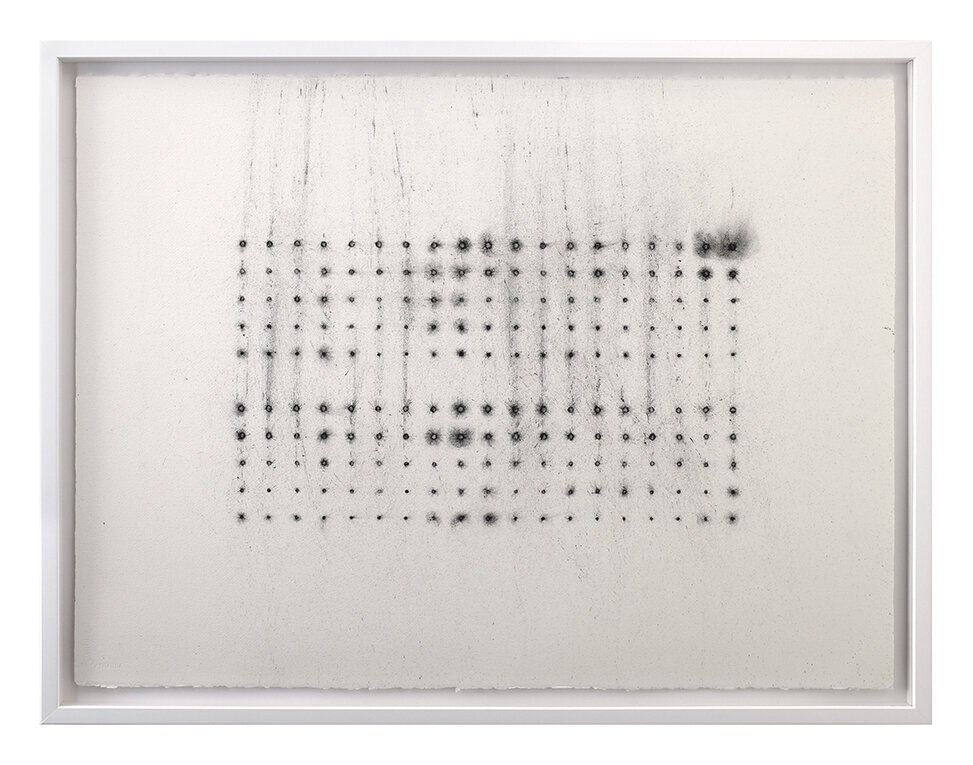
Charcoal on paper
24.875" x 32.5"
2021
This piece presents a reinterpretation of the autoradiogram, first developed in 1977, which is a photograph of DNA that is produced by radiation from radioactive material within that DNA. The photograph reveals the distribution and location of nucleotides that form DNA.

Pastel on paper
24.875" x 32.5"
2021
Our DNA is made up of four different molecules, together called nucleotides (usually represented in biology by the colors red, green, blue and yellow), the order of which is unique to each individual. Currently in crime labs across the U.S., technicians look at sections of these nucleotide patterns called “Short Tandem Repeats” (STRs) to determine if the DNA in evidence matches a suspect. This method, which began with four sections in 1994 but evolved to twenty sections in 2017, can now achieve a match at an approximate probability of 1 in a quadrillion. This work looks at the specific STR patterns, as dictated by the National Institute of Standards and Technology, that are currently analyzed in crime labs.
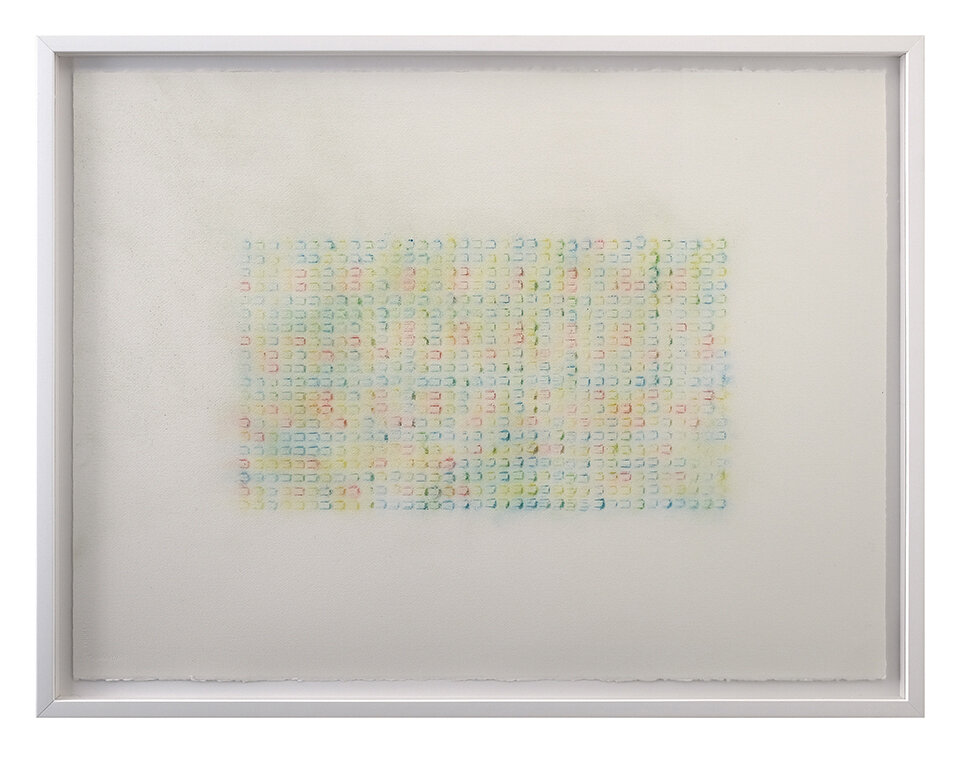
Pastel on paper
24.875" x 32.5"
2021
Our DNA is made up of four different molecules, together called nucleotides (usually represented in biology by the colors red, green, blue and yellow), the order of which is unique to each individual. Currently in crime labs across the U.S., technicians look at sections of these nucleotide patterns called “Short Tandem Repeats” (STRs) to determine if the DNA in evidence matches a suspect. This method, which began with four sections in 1994 but evolved to twenty sections in 2017, can now achieve a match at an approximate probability of 1 in a quadrillion. This work looks at the specific STR patterns, as dictated by the National Institute of Standards and Technology, that are currently analyzed in crime labs.
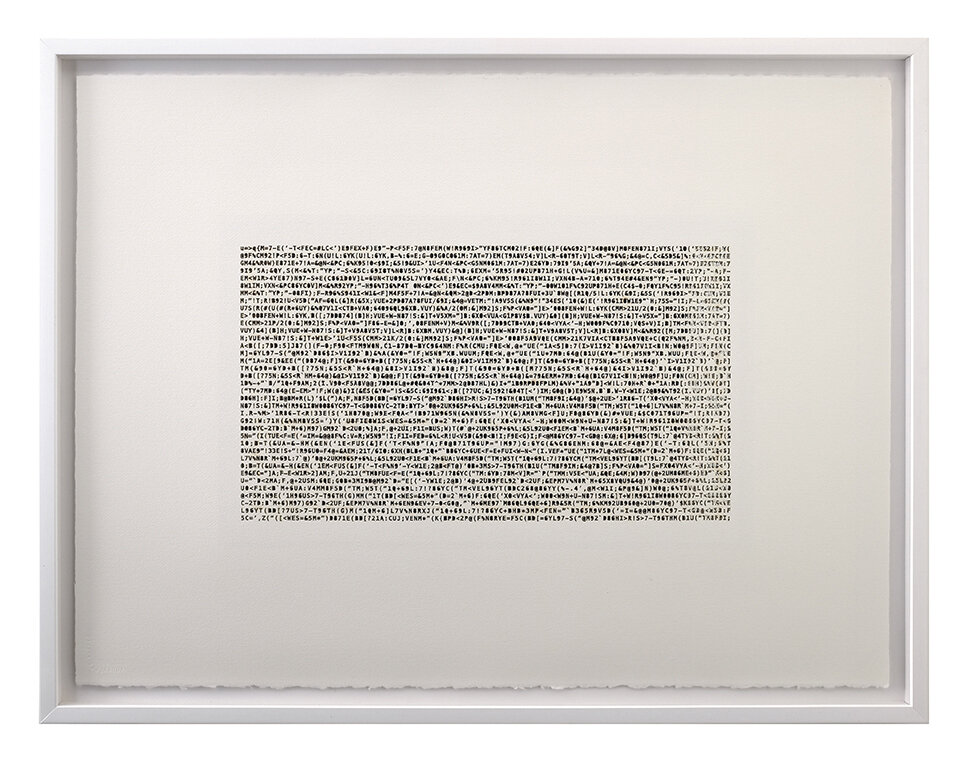
Cut paper with mirror
24.875" x 32.5"
2021
Created in collaboration with Ellen McRae Greytak, Ph.D., Director of Bioinformatics, Parabon NanoLabs, Inc.
The process of DNA phenotyping reads the parts of an individual’s 23 pairs of chromosomes that code for the differences between people such as skin color, eye color, hair color, and the shape of facial features. This process allows for the creation a sketch of an individual’s face using only a small sample of their DNA. The technique uses an ever-expanding database of DNA donated by people across the world and advanced machine learning algorithms that are proprietary to Parabon Nanolabs, a biotech company in the U.S. that began this work in the early 2010s. Obfuscated Phenotype 001 represents an encrypted section of the code behind the algorithm that was created by Parabon.
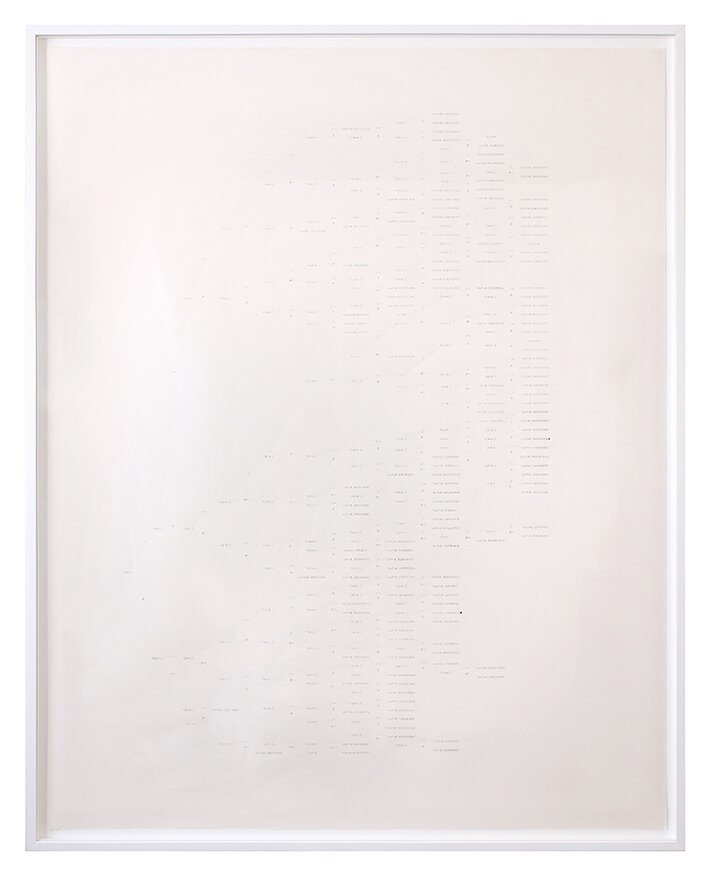
Graphite and colored film with cut and hand embossed paper
55" x 44.5"
2021
Created in collaboration with Ellen McRae Greytak, Ph.D., Director of Bioinformatics, Parabon NanoLabs, Inc.
This work considers the decision-making process that the algorithmic intelligence invented by Parabon Nanolabs uses to calculate eye color probability from a sample of DNA. The process was initially created in the late 2000s to deduce the probabilities of brown and blue eye color, and later evolved to calculate the probabilities of other eye colors, all facial features, skin tone, and hair color, as well.

Graphite and colored film with cut and hand embossed paper
55" x 44.5"
2021
Created in collaboration with Ellen McRae Greytak, Ph.D., Director of Bioinformatics, Parabon NanoLabs, Inc.
This work considers the decision-making process that the algorithmic intelligence invented by Parabon Nanolabs uses to calculate eye color probability from a sample of DNA. The process was initially created in the late 2000s to deduce the probabilities of brown and blue eye color, and later evolved to calculate the probabilities of other eye colors, all facial features, skin tone, and hair color, as well.

Graphite and colored film with cut and hand embossed paper
55" x 44.5"
2021
Created in collaboration with Ellen McRae Greytak, Ph.D., Director of Bioinformatics, Parabon NanoLabs, Inc.
This work considers the decision-making process that the algorithmic intelligence invented by Parabon Nanolabs uses to calculate eye color probability from a sample of DNA. The process was initially created in the late 2000s to deduce the probabilities of brown and blue eye color, and later evolved to calculate the probabilities of other eye colors, all facial features, skin tone, and hair color, as well.
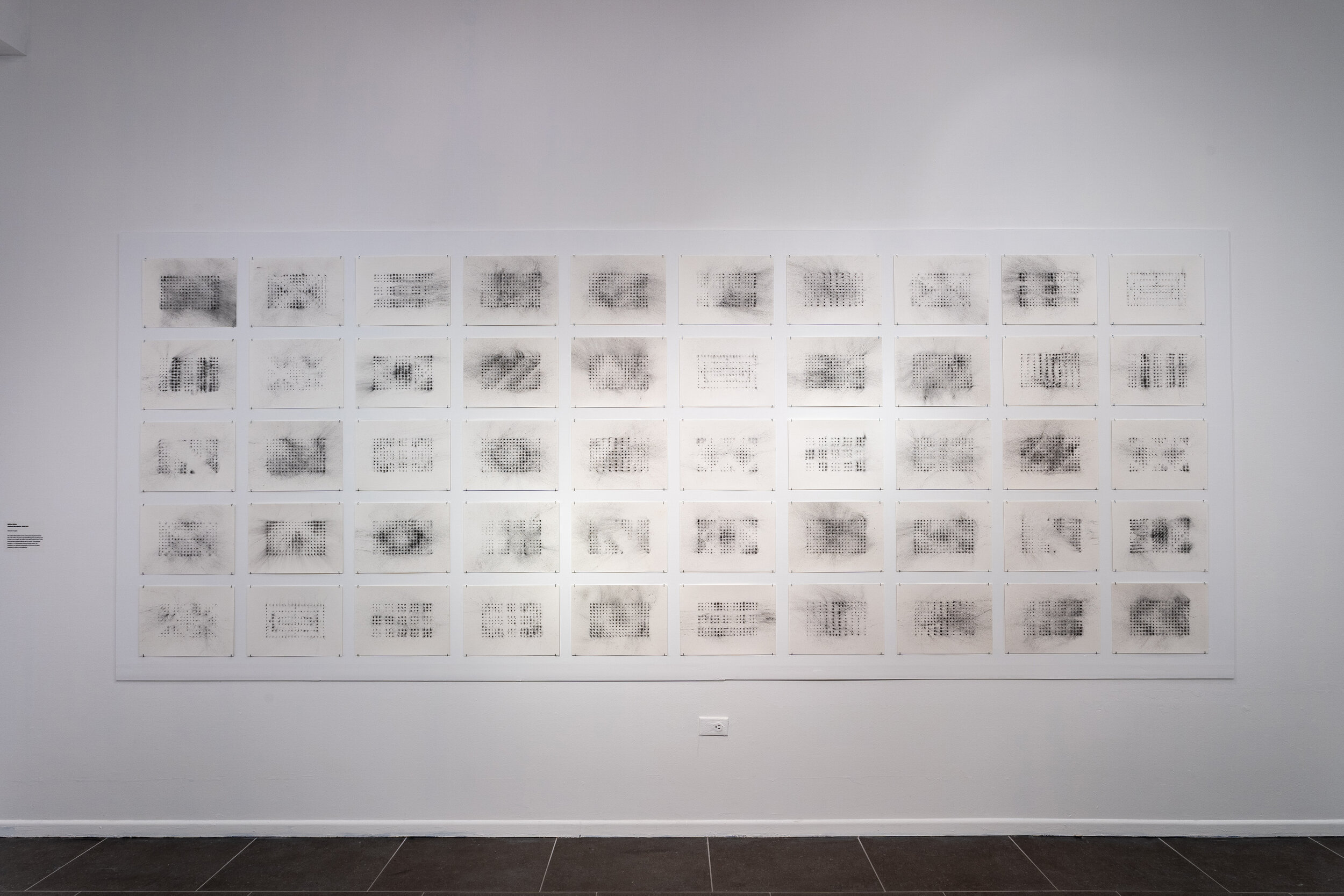
Charcoal on paper
100 individual works at 11” x 15”
2020 – 2021
The Southern Blot method was first used in police department forensic labs in the 1990s. The process separated DNA fragments according to size to create a visual pattern; the pattern of the DNA in evidence from a crime scene was then compared with the DNA of a suspect. This technique provided a 1 in 100 probability of being of being a match. This installation is an abstracted representation of the process of pattern recognition in relation to that probability.
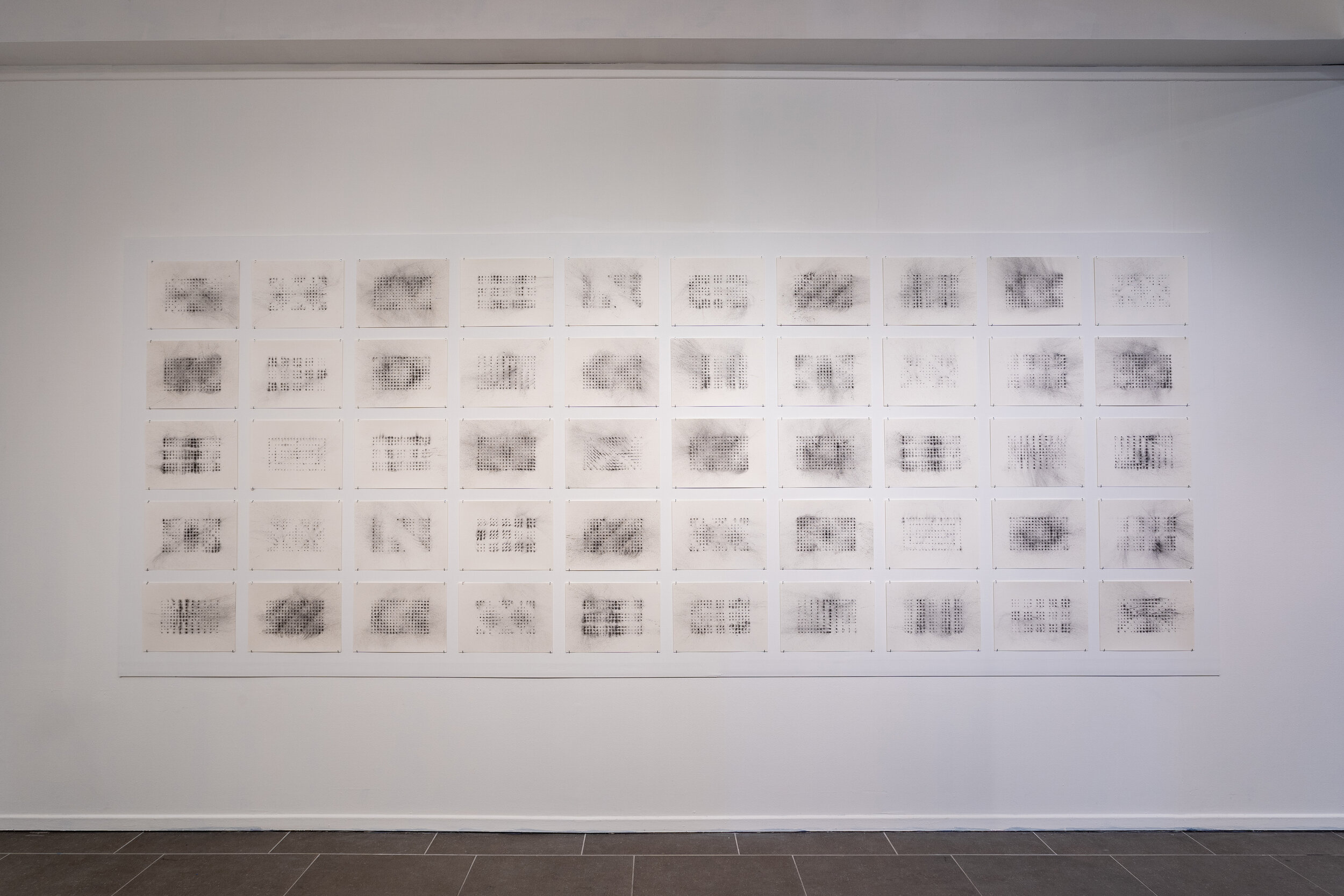
Charcoal on paper
100 individual works at 11” x 15”
2020 – 2021
The Southern Blot method was first used in police department forensic labs in the 1990s. The process separated DNA fragments according to size to create a visual pattern; the pattern of the DNA in evidence from a crime scene was then compared with the DNA of a suspect. This technique provided a 1 in 100 probability of being of being a match. This installation is an abstracted representation of the process of pattern recognition in relation to that probability.

Oceanside Museum of Art
July 17 - November 7, 2021
In Smallest of Places, my work considers the development of DNA analysis in relation to forensic science—the application of science to criminal and civil laws.
This exhibition explores the three main stages in the development of DNA analysis used to process criminal evidence. The mark-making techniques move from visceral to more precise, reflecting the evolution in accuracy as the technology has developed. Smallest of Places provides a glimpse into the science behind these processes and, ultimately, cultivates conversation around equity in the criminal justice system.
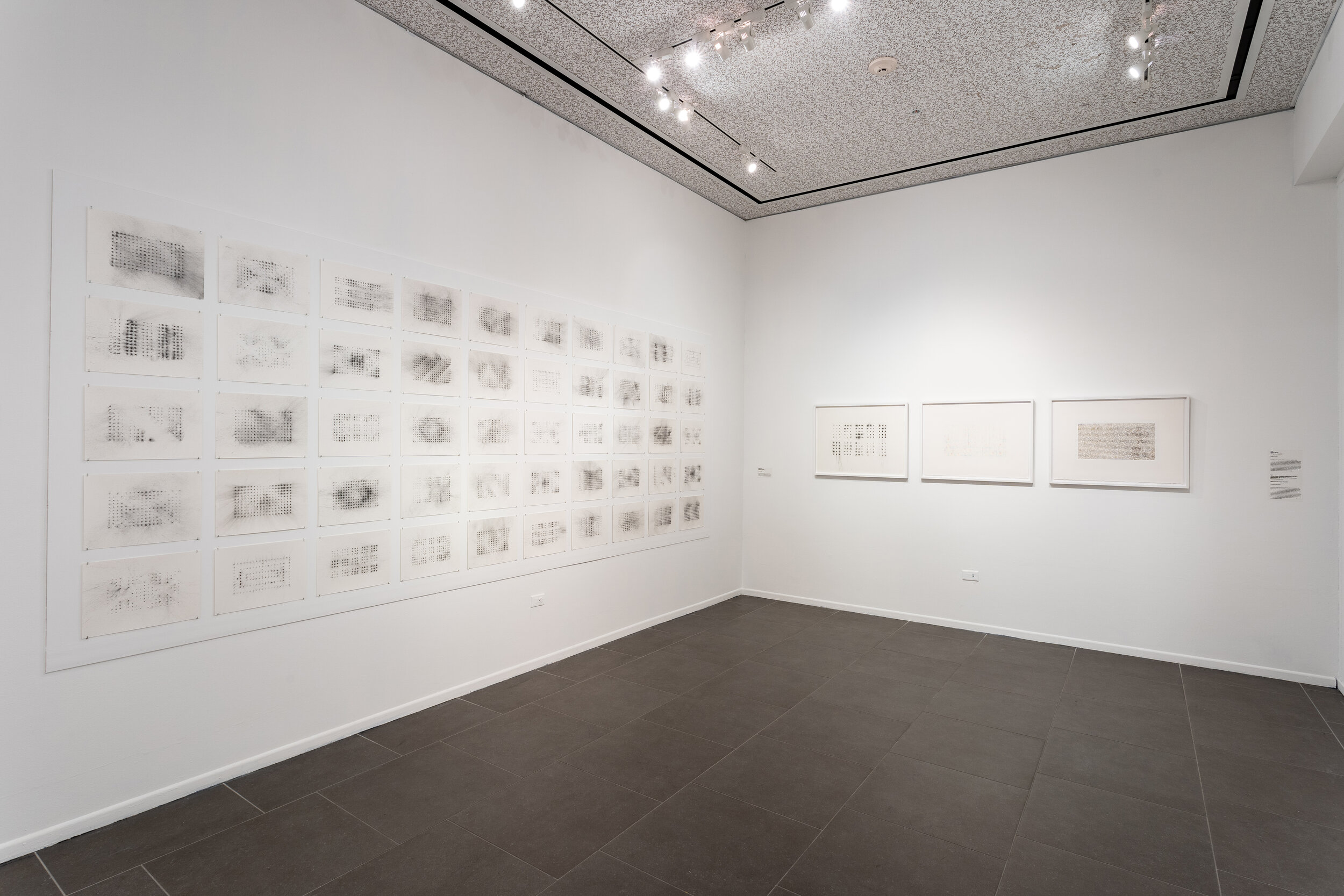
Oceanside Museum of Art
July 17 - November 7, 2021
Left to right: Southern Blot Method (one section of two), Autoradiogram 002, STR Systems 006, Obfuscated Phenotype
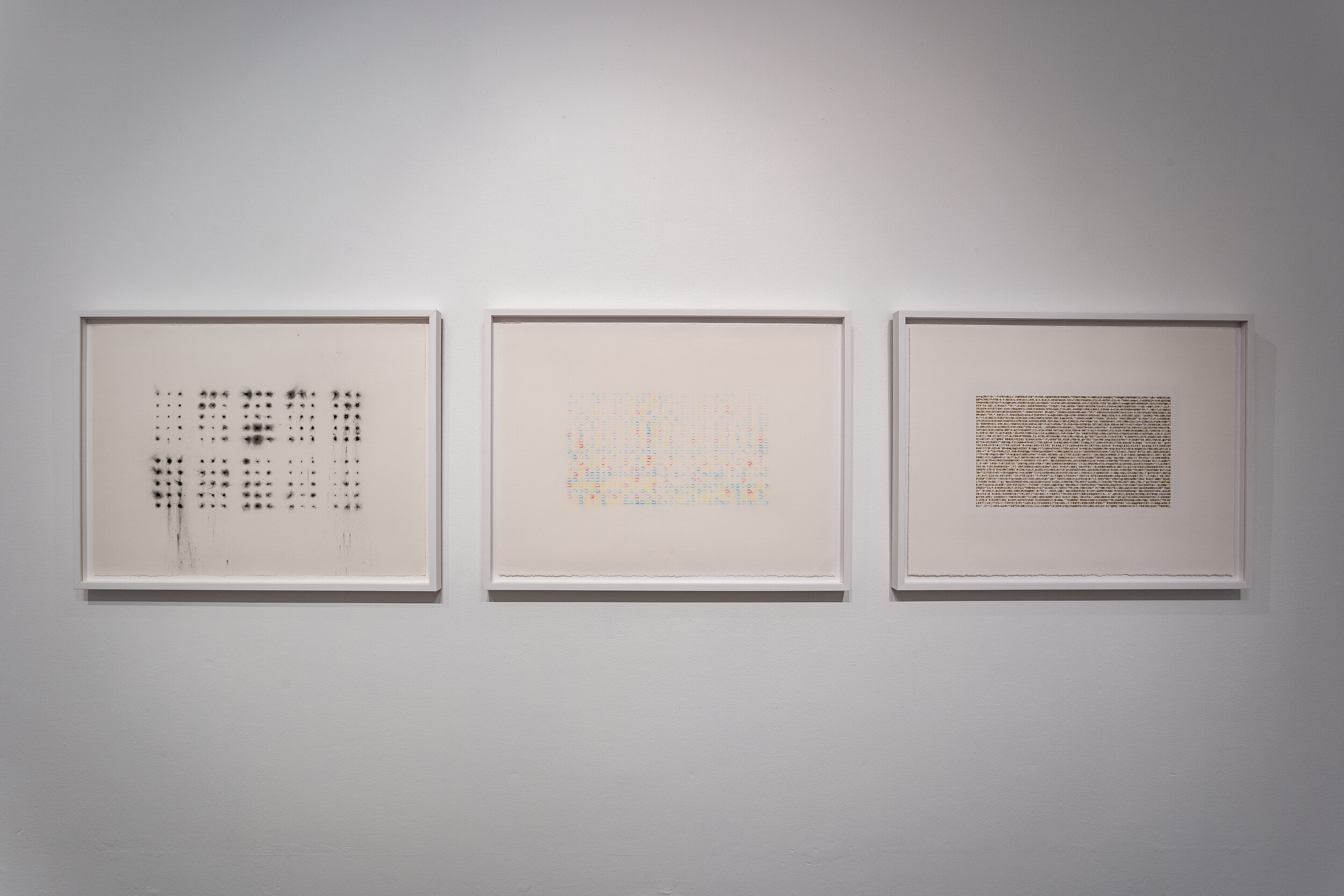
Oceanside Museum of Art
July 17 - November 7, 2021
Left to right: Autoradiogram 002, STR Systems 006, Obfuscated Phenotype 001

Pastel on cut paper
24.875" x 32.5"
2021
Our DNA is made up of four different molecules, together called nucleotides (usually represented in biology by the colors red, green, blue and yellow), the order of which is unique to each individual. Currently in crime labs across the U.S., technicians look at sections of these nucleotide patterns called “Short Tandem Repeats” (STRs) to determine if the DNA in evidence matches a suspect. This method, which began with four sections in 1994 but evolved to twenty sections in 2017, can now achieve a match at an approximate probability of 1 in a quadrillion. This work looks at the specific STR patterns, as dictated by the National Institute of Standards and Technology, that are currently analyzed in crime labs.
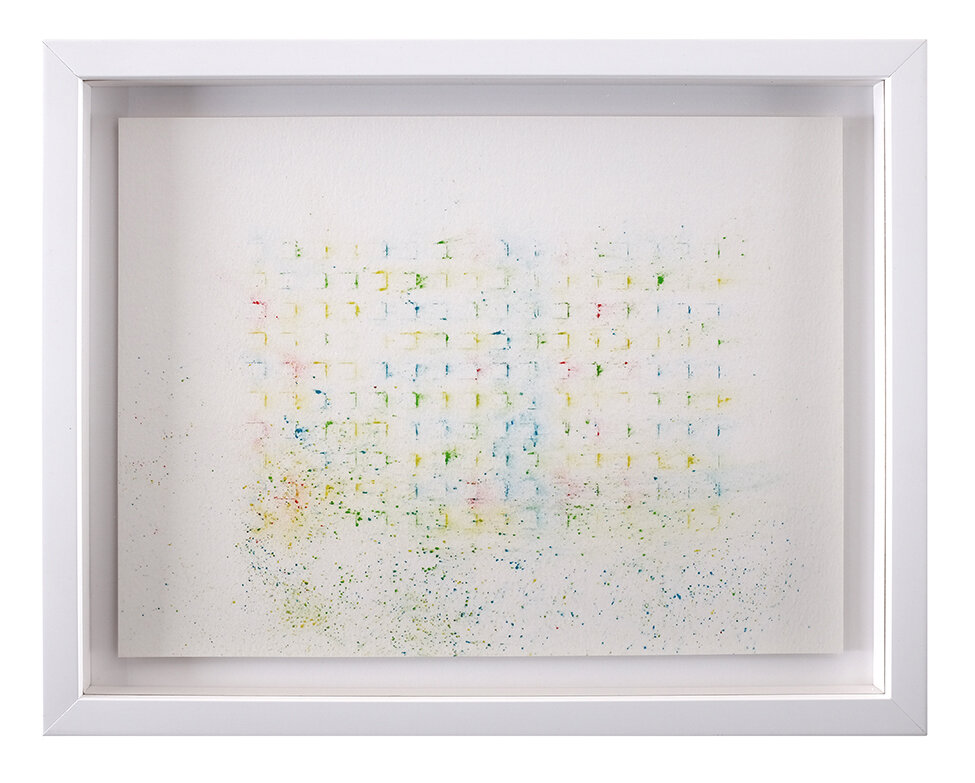
Colored Pastel on Cut Paper
11 3/8” x 14 3/8”
2021
This work in an abstracted view of the current process used for DNA analysis in crime labs across the United States.
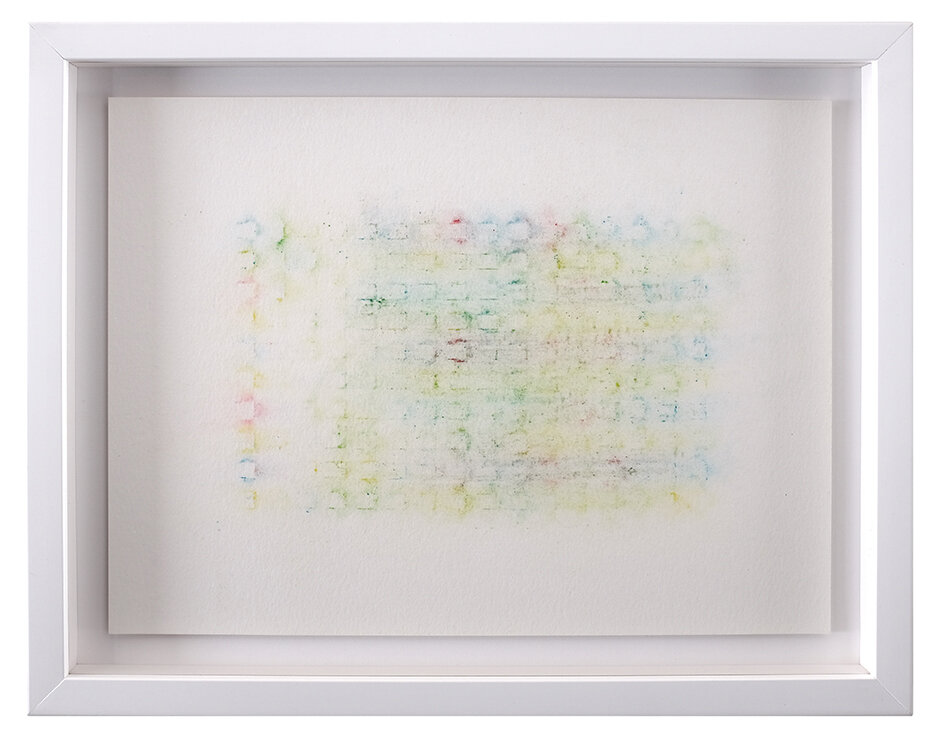
Colored Pastel on Cut Paper
11 3/8” x 14 3/8”
2021
This work in an abstracted view of the current process used for DNA analysis in crime labs across the United States.
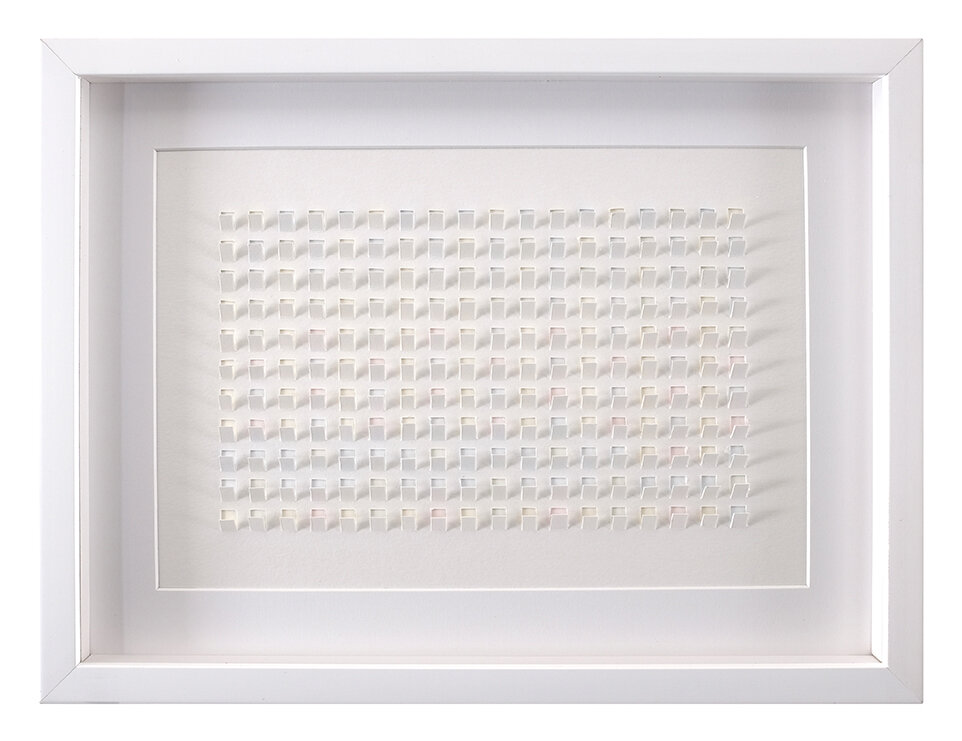
Colored Pencil on Cut Paper, Reflection, and Shadow
10 7/8” x 14 3/8”
2021
This work in an abstracted view of the current process used for DNA analysis in crime labs across the United States.

Colored Pencil on Paper
12 7/8” x 12 7/8”
2021
This work in an abstracted view of the current process used for DNA analysis in crime labs across the United States.
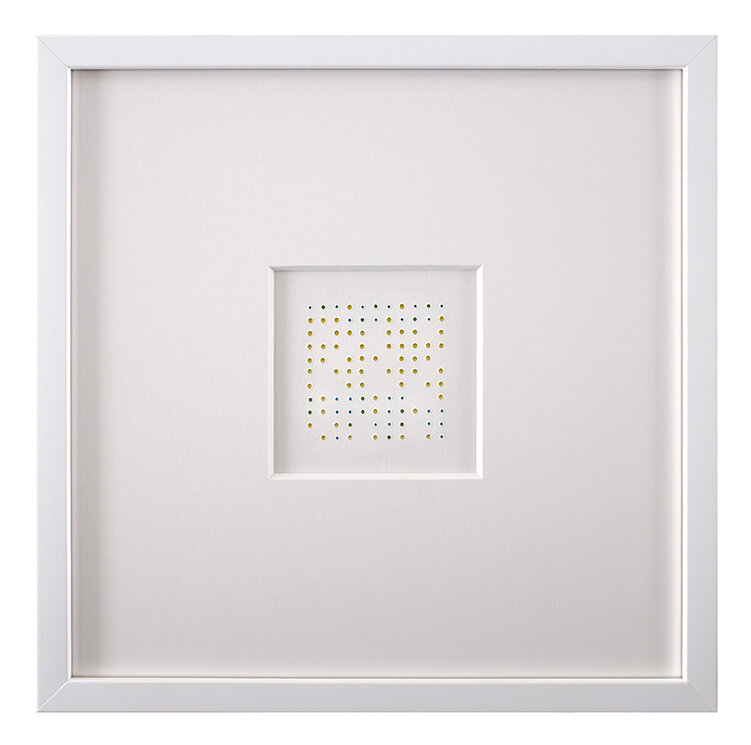
Colored Pencil and Cut Paper
12 7/8” x 12 7/8”
2021
This work in an abstracted view of the current process used for DNA analysis in crime labs across the United States.

Cut Paper
12 7/8” x 12 7/8”
2021
This work in an abstracted view of the current process used for DNA analysis in crime labs across the United States.
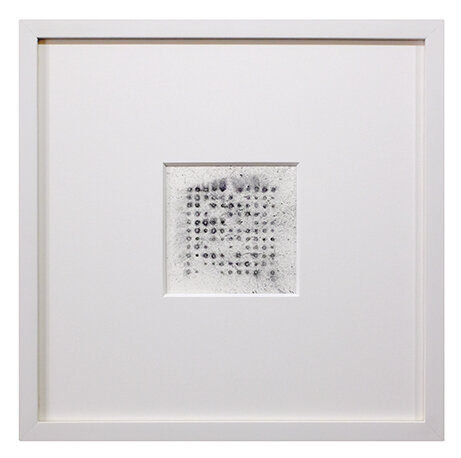
Charcoal on Paper
12 7/8” x 12 7/8”
2021
This work in an abstracted view of the current process used for DNA analysis in crime labs across the United States.

25" x 19"
Paper on board
As the light from a distant object (like a galaxy or a star) comes toward our telescopes, that light may interact with very dense objects (like dark matter) before it reaches us. This causes a phenomenon called “gravitational lensing” where the light itself is bent and twisted by the gravity of the very dense object. As a result, the telescope will produce an image that is distorted. Astronomers can then take the data from these warped images to piece together what is truly happening so far away.
The "Distortion" series is a visual reflection of this phenomenon. It also provides space for us to consider that our individual viewpoint can often be a distorted version of the truth, especially in relation to the experience of another person. However, taking the time to question and analyze our perspective can in turn provide an avenue toward better understanding realities outside of our own.
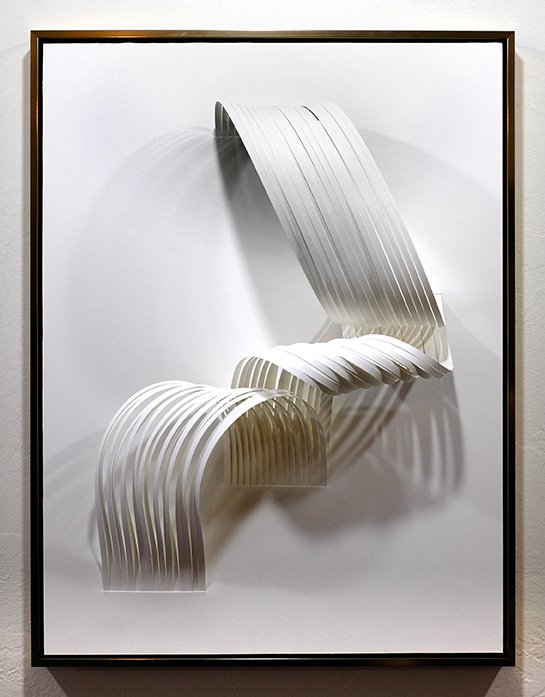
25" x 19"
Paper on board
As the light from a distant object (like a galaxy or a star) comes toward our telescopes, that light may interact with very dense objects (like dark matter) before it reaches us. This causes a phenomenon called “gravitational lensing” where the light itself is bent and twisted by the gravity of the very dense object. As a result, the telescope will produce an image that is distorted. Astronomers can then take the data from these warped images to piece together what is truly happening so far away.
The "Distortion" series is a visual reflection of this phenomenon. It also provides space for us to consider that our individual viewpoint can often be a distorted version of the truth, especially in relation to the experience of another person. However, taking the time to question and analyze our perspective can in turn provide an avenue toward better understanding realities outside of our own.
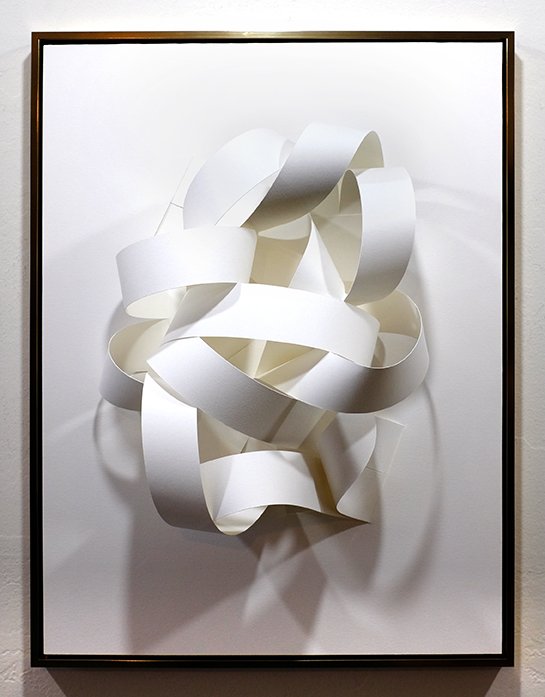
25" x 19"
Paper on board
As the light from a distant object (like a galaxy or a star) comes toward our telescopes, that light may interact with very dense objects (like dark matter) before it reaches us. This causes a phenomenon called “gravitational lensing” where the light itself is bent and twisted by the gravity of the very dense object. As a result, the telescope will produce an image that is distorted. Astronomers can then take the data from these warped images to piece together what is truly happening so far away.
The "Distortion" series is a visual reflection of this phenomenon. It also provides space for us to consider that our individual viewpoint can often be a distorted version of the truth, especially in relation to the experience of another person. However, taking the time to question and analyze our perspective can in turn provide an avenue toward better understanding realities outside of our own.

25" x 19"
Paper on board
As the light from a distant object (like a galaxy or a star) comes toward our telescopes, that light may interact with very dense objects (like dark matter) before it reaches us. This causes a phenomenon called “gravitational lensing” where the light itself is bent and twisted by the gravity of the very dense object. As a result, the telescope will produce an image that is distorted. Astronomers can then take the data from these warped images to piece together what is truly happening so far away.
The "Distortion" series is a visual reflection of this phenomenon. It also provides space for us to consider that our individual viewpoint can often be a distorted version of the truth, especially in relation to the experience of another person. However, taking the time to question and analyze our perspective can in turn provide an avenue toward better understanding realities outside of our own.
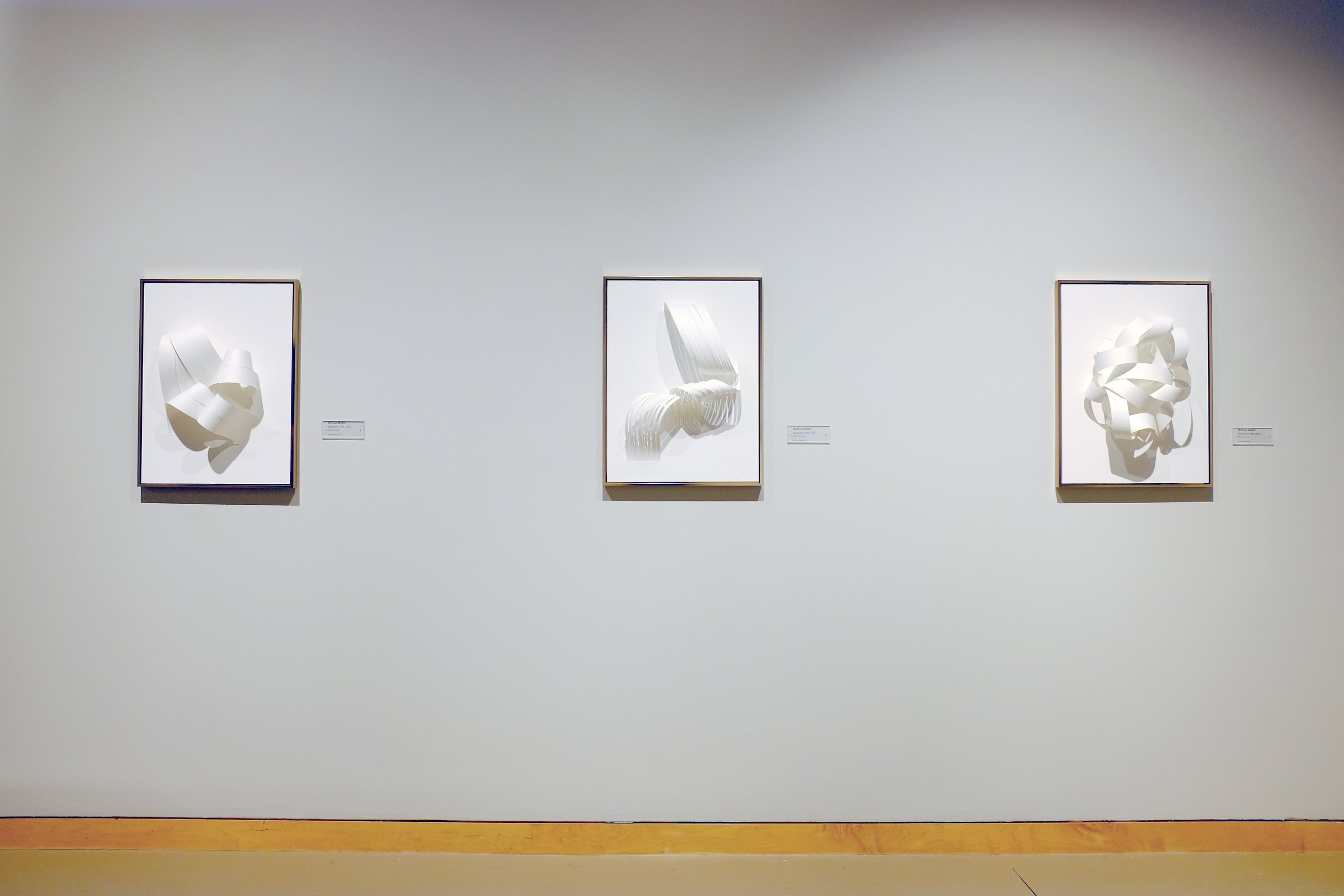
William D. Cannon Gallery
2021 Cannon Invitational
Nov. 13, 2021 - Feb. 5, 2022
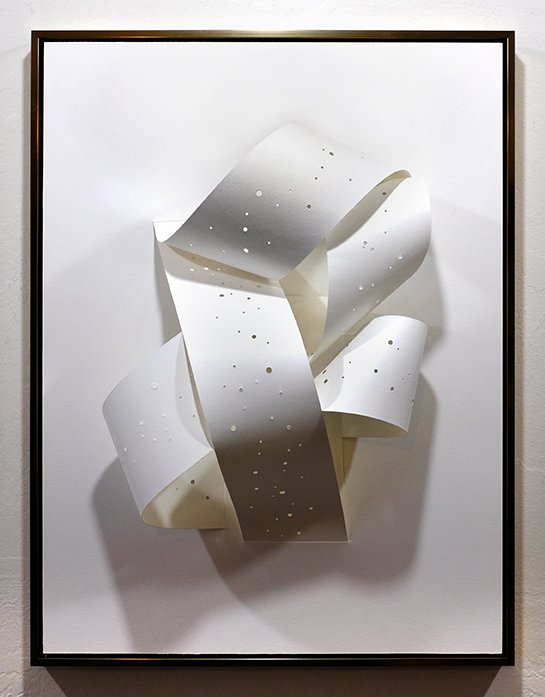
25" x 19"
Paper on board
As the light from a distant object (like a galaxy or a star) comes toward our telescopes, that light may interact with very dense objects (like dark matter) before it reaches us. This causes a phenomenon called “gravitational lensing” where the light itself is bent and twisted by the gravity of the very dense object. As a result, the telescope will produce an image that is distorted. Astronomers can then take the data from these warped images to piece together what is truly happening so far away.
The "Distortion" series is a visual reflection of this phenomenon. It also provides space for us to consider that our individual viewpoint can often be a distorted version of the truth, especially in relation to the experience of another person. However, taking the time to question and analyze our perspective can in turn provide an avenue toward better understanding realities outside of our own.
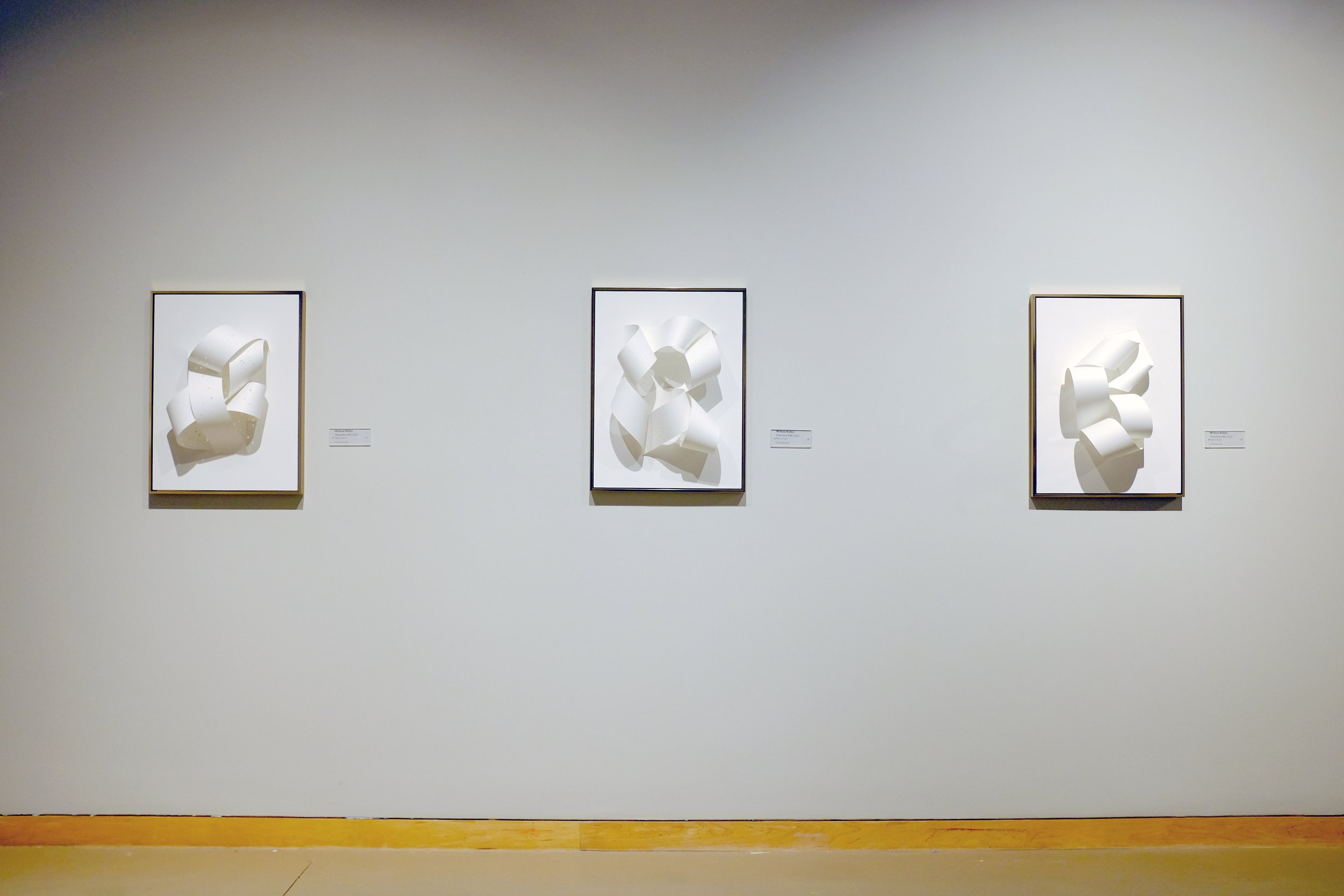
William D. Cannon Gallery
2021 Cannon Invitational
Nov. 13, 2021 - Feb. 5, 2022
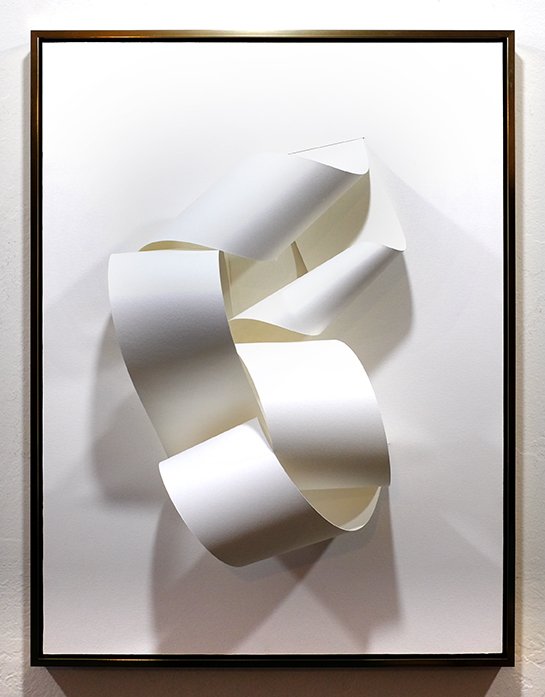
25" x 19"
Paper on board
As the light from a distant object (like a galaxy or a star) comes toward our telescopes, that light may interact with very dense objects (like dark matter) before it reaches us. This causes a phenomenon called “gravitational lensing” where the light itself is bent and twisted by the gravity of the very dense object. As a result, the telescope will produce an image that is distorted. Astronomers can then take the data from these warped images to piece together what is truly happening so far away.
The "Distortion" series is a visual reflection of this phenomenon. It also provides space for us to consider that our individual viewpoint can often be a distorted version of the truth, especially in relation to the experience of another person. However, taking the time to question and analyze our perspective can in turn provide an avenue toward better understanding realities outside of our own.






























Charcoal on paper
24.875" x 32.5"
2021
This piece presents a reinterpretation of the autoradiogram, first developed in 1977, which is a photograph of DNA that is produced by radiation from radioactive material within that DNA. The photograph reveals the distribution and location of nucleotides that form DNA.
Charcoal on paper
24.875" x 32.5"
2021
This piece presents a reinterpretation of the autoradiogram, first developed in 1977, which is a photograph of DNA that is produced by radiation from radioactive material within that DNA. The photograph reveals the distribution and location of nucleotides that form DNA.
Charcoal on paper
24.875" x 32.5"
2021
This piece presents a reinterpretation of the autoradiogram, first developed in 1977, which is a photograph of DNA that is produced by radiation from radioactive material within that DNA. The photograph reveals the distribution and location of nucleotides that form DNA.
Pastel on paper
24.875" x 32.5"
2021
Our DNA is made up of four different molecules, together called nucleotides (usually represented in biology by the colors red, green, blue and yellow), the order of which is unique to each individual. Currently in crime labs across the U.S., technicians look at sections of these nucleotide patterns called “Short Tandem Repeats” (STRs) to determine if the DNA in evidence matches a suspect. This method, which began with four sections in 1994 but evolved to twenty sections in 2017, can now achieve a match at an approximate probability of 1 in a quadrillion. This work looks at the specific STR patterns, as dictated by the National Institute of Standards and Technology, that are currently analyzed in crime labs.
Pastel on paper
24.875" x 32.5"
2021
Our DNA is made up of four different molecules, together called nucleotides (usually represented in biology by the colors red, green, blue and yellow), the order of which is unique to each individual. Currently in crime labs across the U.S., technicians look at sections of these nucleotide patterns called “Short Tandem Repeats” (STRs) to determine if the DNA in evidence matches a suspect. This method, which began with four sections in 1994 but evolved to twenty sections in 2017, can now achieve a match at an approximate probability of 1 in a quadrillion. This work looks at the specific STR patterns, as dictated by the National Institute of Standards and Technology, that are currently analyzed in crime labs.
Cut paper with mirror
24.875" x 32.5"
2021
Created in collaboration with Ellen McRae Greytak, Ph.D., Director of Bioinformatics, Parabon NanoLabs, Inc.
The process of DNA phenotyping reads the parts of an individual’s 23 pairs of chromosomes that code for the differences between people such as skin color, eye color, hair color, and the shape of facial features. This process allows for the creation a sketch of an individual’s face using only a small sample of their DNA. The technique uses an ever-expanding database of DNA donated by people across the world and advanced machine learning algorithms that are proprietary to Parabon Nanolabs, a biotech company in the U.S. that began this work in the early 2010s. Obfuscated Phenotype 001 represents an encrypted section of the code behind the algorithm that was created by Parabon.
Graphite and colored film with cut and hand embossed paper
55" x 44.5"
2021
Created in collaboration with Ellen McRae Greytak, Ph.D., Director of Bioinformatics, Parabon NanoLabs, Inc.
This work considers the decision-making process that the algorithmic intelligence invented by Parabon Nanolabs uses to calculate eye color probability from a sample of DNA. The process was initially created in the late 2000s to deduce the probabilities of brown and blue eye color, and later evolved to calculate the probabilities of other eye colors, all facial features, skin tone, and hair color, as well.
Graphite and colored film with cut and hand embossed paper
55" x 44.5"
2021
Created in collaboration with Ellen McRae Greytak, Ph.D., Director of Bioinformatics, Parabon NanoLabs, Inc.
This work considers the decision-making process that the algorithmic intelligence invented by Parabon Nanolabs uses to calculate eye color probability from a sample of DNA. The process was initially created in the late 2000s to deduce the probabilities of brown and blue eye color, and later evolved to calculate the probabilities of other eye colors, all facial features, skin tone, and hair color, as well.
Graphite and colored film with cut and hand embossed paper
55" x 44.5"
2021
Created in collaboration with Ellen McRae Greytak, Ph.D., Director of Bioinformatics, Parabon NanoLabs, Inc.
This work considers the decision-making process that the algorithmic intelligence invented by Parabon Nanolabs uses to calculate eye color probability from a sample of DNA. The process was initially created in the late 2000s to deduce the probabilities of brown and blue eye color, and later evolved to calculate the probabilities of other eye colors, all facial features, skin tone, and hair color, as well.
Charcoal on paper
100 individual works at 11” x 15”
2020 – 2021
The Southern Blot method was first used in police department forensic labs in the 1990s. The process separated DNA fragments according to size to create a visual pattern; the pattern of the DNA in evidence from a crime scene was then compared with the DNA of a suspect. This technique provided a 1 in 100 probability of being of being a match. This installation is an abstracted representation of the process of pattern recognition in relation to that probability.
Charcoal on paper
100 individual works at 11” x 15”
2020 – 2021
The Southern Blot method was first used in police department forensic labs in the 1990s. The process separated DNA fragments according to size to create a visual pattern; the pattern of the DNA in evidence from a crime scene was then compared with the DNA of a suspect. This technique provided a 1 in 100 probability of being of being a match. This installation is an abstracted representation of the process of pattern recognition in relation to that probability.
Oceanside Museum of Art
July 17 - November 7, 2021
In Smallest of Places, my work considers the development of DNA analysis in relation to forensic science—the application of science to criminal and civil laws.
This exhibition explores the three main stages in the development of DNA analysis used to process criminal evidence. The mark-making techniques move from visceral to more precise, reflecting the evolution in accuracy as the technology has developed. Smallest of Places provides a glimpse into the science behind these processes and, ultimately, cultivates conversation around equity in the criminal justice system.
Oceanside Museum of Art
July 17 - November 7, 2021
Left to right: Southern Blot Method (one section of two), Autoradiogram 002, STR Systems 006, Obfuscated Phenotype
Oceanside Museum of Art
July 17 - November 7, 2021
Left to right: Autoradiogram 002, STR Systems 006, Obfuscated Phenotype 001
Pastel on cut paper
24.875" x 32.5"
2021
Our DNA is made up of four different molecules, together called nucleotides (usually represented in biology by the colors red, green, blue and yellow), the order of which is unique to each individual. Currently in crime labs across the U.S., technicians look at sections of these nucleotide patterns called “Short Tandem Repeats” (STRs) to determine if the DNA in evidence matches a suspect. This method, which began with four sections in 1994 but evolved to twenty sections in 2017, can now achieve a match at an approximate probability of 1 in a quadrillion. This work looks at the specific STR patterns, as dictated by the National Institute of Standards and Technology, that are currently analyzed in crime labs.
Colored Pastel on Cut Paper
11 3/8” x 14 3/8”
2021
This work in an abstracted view of the current process used for DNA analysis in crime labs across the United States.
Colored Pastel on Cut Paper
11 3/8” x 14 3/8”
2021
This work in an abstracted view of the current process used for DNA analysis in crime labs across the United States.
Colored Pencil on Cut Paper, Reflection, and Shadow
10 7/8” x 14 3/8”
2021
This work in an abstracted view of the current process used for DNA analysis in crime labs across the United States.
Colored Pencil on Paper
12 7/8” x 12 7/8”
2021
This work in an abstracted view of the current process used for DNA analysis in crime labs across the United States.
Colored Pencil and Cut Paper
12 7/8” x 12 7/8”
2021
This work in an abstracted view of the current process used for DNA analysis in crime labs across the United States.
Cut Paper
12 7/8” x 12 7/8”
2021
This work in an abstracted view of the current process used for DNA analysis in crime labs across the United States.
Charcoal on Paper
12 7/8” x 12 7/8”
2021
This work in an abstracted view of the current process used for DNA analysis in crime labs across the United States.
25" x 19"
Paper on board
As the light from a distant object (like a galaxy or a star) comes toward our telescopes, that light may interact with very dense objects (like dark matter) before it reaches us. This causes a phenomenon called “gravitational lensing” where the light itself is bent and twisted by the gravity of the very dense object. As a result, the telescope will produce an image that is distorted. Astronomers can then take the data from these warped images to piece together what is truly happening so far away.
The "Distortion" series is a visual reflection of this phenomenon. It also provides space for us to consider that our individual viewpoint can often be a distorted version of the truth, especially in relation to the experience of another person. However, taking the time to question and analyze our perspective can in turn provide an avenue toward better understanding realities outside of our own.
25" x 19"
Paper on board
As the light from a distant object (like a galaxy or a star) comes toward our telescopes, that light may interact with very dense objects (like dark matter) before it reaches us. This causes a phenomenon called “gravitational lensing” where the light itself is bent and twisted by the gravity of the very dense object. As a result, the telescope will produce an image that is distorted. Astronomers can then take the data from these warped images to piece together what is truly happening so far away.
The "Distortion" series is a visual reflection of this phenomenon. It also provides space for us to consider that our individual viewpoint can often be a distorted version of the truth, especially in relation to the experience of another person. However, taking the time to question and analyze our perspective can in turn provide an avenue toward better understanding realities outside of our own.
25" x 19"
Paper on board
As the light from a distant object (like a galaxy or a star) comes toward our telescopes, that light may interact with very dense objects (like dark matter) before it reaches us. This causes a phenomenon called “gravitational lensing” where the light itself is bent and twisted by the gravity of the very dense object. As a result, the telescope will produce an image that is distorted. Astronomers can then take the data from these warped images to piece together what is truly happening so far away.
The "Distortion" series is a visual reflection of this phenomenon. It also provides space for us to consider that our individual viewpoint can often be a distorted version of the truth, especially in relation to the experience of another person. However, taking the time to question and analyze our perspective can in turn provide an avenue toward better understanding realities outside of our own.
25" x 19"
Paper on board
As the light from a distant object (like a galaxy or a star) comes toward our telescopes, that light may interact with very dense objects (like dark matter) before it reaches us. This causes a phenomenon called “gravitational lensing” where the light itself is bent and twisted by the gravity of the very dense object. As a result, the telescope will produce an image that is distorted. Astronomers can then take the data from these warped images to piece together what is truly happening so far away.
The "Distortion" series is a visual reflection of this phenomenon. It also provides space for us to consider that our individual viewpoint can often be a distorted version of the truth, especially in relation to the experience of another person. However, taking the time to question and analyze our perspective can in turn provide an avenue toward better understanding realities outside of our own.
William D. Cannon Gallery
2021 Cannon Invitational
Nov. 13, 2021 - Feb. 5, 2022
25" x 19"
Paper on board
As the light from a distant object (like a galaxy or a star) comes toward our telescopes, that light may interact with very dense objects (like dark matter) before it reaches us. This causes a phenomenon called “gravitational lensing” where the light itself is bent and twisted by the gravity of the very dense object. As a result, the telescope will produce an image that is distorted. Astronomers can then take the data from these warped images to piece together what is truly happening so far away.
The "Distortion" series is a visual reflection of this phenomenon. It also provides space for us to consider that our individual viewpoint can often be a distorted version of the truth, especially in relation to the experience of another person. However, taking the time to question and analyze our perspective can in turn provide an avenue toward better understanding realities outside of our own.
William D. Cannon Gallery
2021 Cannon Invitational
Nov. 13, 2021 - Feb. 5, 2022
25" x 19"
Paper on board
As the light from a distant object (like a galaxy or a star) comes toward our telescopes, that light may interact with very dense objects (like dark matter) before it reaches us. This causes a phenomenon called “gravitational lensing” where the light itself is bent and twisted by the gravity of the very dense object. As a result, the telescope will produce an image that is distorted. Astronomers can then take the data from these warped images to piece together what is truly happening so far away.
The "Distortion" series is a visual reflection of this phenomenon. It also provides space for us to consider that our individual viewpoint can often be a distorted version of the truth, especially in relation to the experience of another person. However, taking the time to question and analyze our perspective can in turn provide an avenue toward better understanding realities outside of our own.
